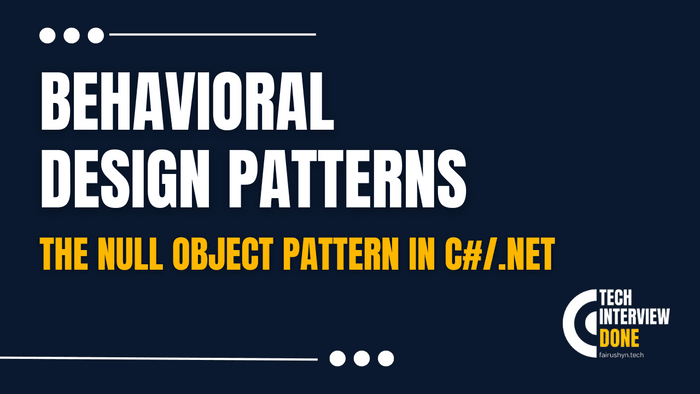The Null Object Pattern in C#/.NET
3 min read · — #design-patterns#structrural-patterns#null-object
Introduction
In the vibrant world of software engineering, mastering design patterns is akin to a martial artist honing their
technique to perfection. Among these patterns, the Null Object Pattern stands out for its elegant simplicity and
profound impact on code robustness and readability. This pattern embodies the principle of designing our software in
such a way that we replace null checks with polymorphic behavior, thereby reducing the risk of NullReferenceException
and streamlining our code.
The Null Object Pattern is a prime example of behavioral design patterns, focusing on how objects interact and distribute responsibilities. It provides an ingenious way to encapsulate the absence of an object by introducing a non-functional substitute that shares the same interface. This strategy proves invaluable in reducing conditional complexity and improving the overall maintainability of the application.
Let's delve into the depths of the Null Object Pattern, exploring its implementation in C#/.NET and unveiling its potential to transform our approach to designing more resilient and clean systems.
The Essence of the Null Object Pattern
The Null Object Pattern is designed to provide an alternative to using null references. Instead of using null to
represent the absence of an object, we create an object that implements the expected interface but does nothing in its
methods. This object is a "null" object.
The benefits of this approach are multifold:
- It eliminates the need for repetitive null checks throughout the codebase.
- It allows methods to safely call on objects without risking a
NullReferenceException. - It simplifies code by ensuring that an object always adheres to a known interface, even when it's effectively "empty."
Real-world Scenario: Logging
Consider a typical application that relies on logging. Logging is a cross-cutting concern that can vary in necessity depending on the context (development, production, testing, etc.). Using the Null Object Pattern, we can seamlessly switch between active logging and a no-operation (no-op) logger without changing the consumer's code.
Step 1: Define the Logger Interface
First, we define a common interface for our loggers:
public interface ILogger
{
void Log(string message);
}Step 2: Implement a Real Logger
Here's a simple implementation of ILogger that writes to the console:
public class ConsoleLogger : ILogger
{
public void Log(string message)
{
Console.WriteLine($"Log: {message}");
}
}Step 3: Implement the Null Logger
Now, we introduce the Null Object Pattern by creating a logger that does nothing:
public class NullLogger : ILogger
{
public void Log(string message)
{
// Do nothing
}
}Step 4: Utilize the Loggers
The consumer code can use the ILogger interface without worrying about null checks or whether logging is enabled:
public class Application
{
private readonly ILogger _logger;
public Application(ILogger logger)
{
_logger = logger ?? throw new ArgumentNullException(nameof(logger));
}
public void DoWork()
{
_logger.Log("Work started.");
// Perform work here...
_logger.Log("Work completed.");
}
}Configuration
Depending on the application's configuration (e.g., a setting in appsettings.json), we can instantiate
either ConsoleLogger or NullLogger:
ILogger logger = new NullLogger(); // Or, new ConsoleLogger() based on configuration
Application app = new Application(logger);
app.DoWork();This example illustrates the elegance and utility of the Null Object Pattern. It allows the Application class to
remain oblivious to the operational context, focusing purely on its business logic. The decision of whether to log is
abstracted away behind the ILogger interface, dramatically reducing the cognitive load on developers and enhancing
code quality.
Conclusion
The Null Object Pattern is a powerful tool in the software engineer's arsenal, enabling cleaner, more maintainable code by abstracting the handling of null references. By applying this pattern in C#/.NET applications, developers can reduce boilerplate code, minimize errors, and focus on delivering features that matter. Whether you're building a large-scale enterprise application or a simple utility library, embracing the Null Object Pattern can lead to more robust and flexible codebases that stand the test of time.
